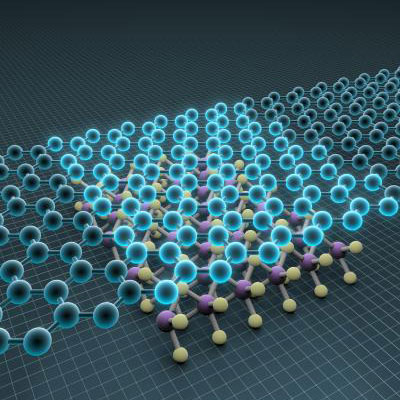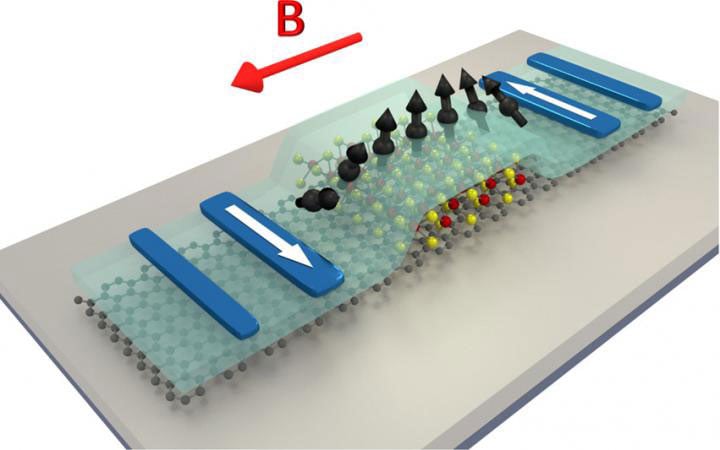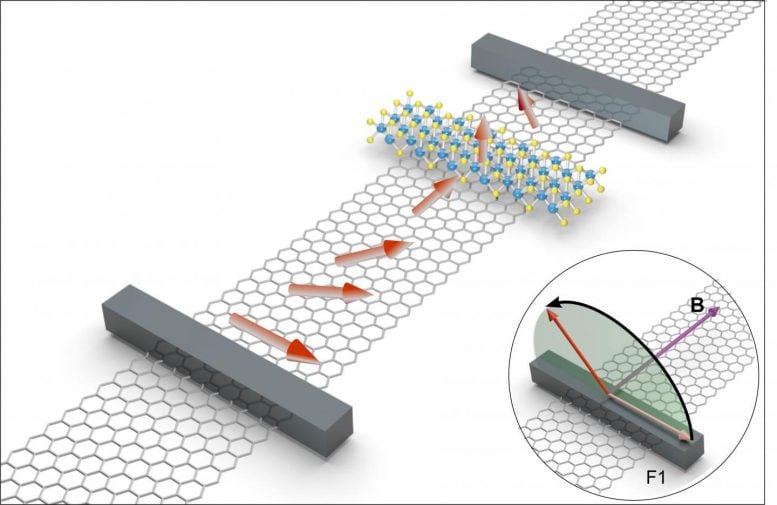Graphene Flagship Paves the Way for New Spintronic Logic Devices

Schematic
image showing graphene-TMD heterostructure. The TMD causes giant
anisotropy in spin transport in graphene. Dámaso Torres, ICN2
Graphene’s excellent tuneable electronic properties make it an ideal material for spintronics applications. Leading the way in three recent papers, Flagship researchers have shown that GRMs can be combined to produce an unprecedented spin lifetime anisotropy, essential for furthering spintronics – electronic circuits and devices based on the manipulation of electron spins. The papers were published almost simultaneously in Physical Review Letters, Nano Letters and Nature Physics.
“These results represent a first step to achieving direct electric-field tuning of the propagation of spins in graphene,” said ICREA Prof. Sergio O. Valenzuela, a researcher at the Catalan Institute of Nanoscience and Nanotechnology (ICN2; Spain), and an author of the experimental results in Nature Physics. “A graphene-TMDC structure responds as a spin filter with a transmission determined by the orientation of the spins that reach it, allowing detection of small orientation changes.”
The prediction and rapid verification of this previously unknown spin-lifetime anisotropy regime would not have been possible without close cooperation between the research teams, working at Graphene Flagship partner institutes ICN2, the University of Groningen (the Netherlands), and the University of Regensburg (Germany). Engaged as part of the Flagship’s dedicated Spintronics work package, the teams maintain close relationships and determine common goals, benefitting from the Flagship’s unique approach to collaborative, interdisciplinary research.
“This is a nice example of how the Flagship makes it possible to make progress by a combination of challenging science and technology, collaborations, and a fruitful interaction between theory and experiment,” said co-author Prof. Bart van Wees (University of Groningen), leader of the Spintronics Work Package. “After our ‘proof of principle’ the next challenge will be to demonstrate and apply our findings in spintronic devices based on large scale graphene and related materials.”

Schematic
image showing spin filter effect of graphene-TMD heterostructure. The
TMD causes giant anisotropy in spin transport in graphene. University of
Groningen
Spintronics is particularly interesting for quantum computing and new kinds of fast and efficient memory storage. Like electronics, spintronics relies on the generation and manipulation of currents. However, in the case of spintronics, the currents are formed from the transport of the electrons’ spins – the intrinsic electron angular momentum with no equivalent in classical physics. In graphene devices, an electron’s spin can be easily injected either parallel or perpendicular to the plan of the graphene layer.
The new research shows that spin transport in graphene can be strongly influenced by proximity effects in heterostructures of graphene and TMDCs, such as molybdenum disulphide and tungsten disulphide. Through inter-layer coupling, the behaviours of the parallel and perpendicular spin orientations in graphene is dramatically altered, leading to an anisotropic spin relaxation from one to several orders of magnitude.
Spin relaxation is the process by which an electron’s spin loses its initial polarization and becomes random, leading to the disappearance of spin information signal. This research provides the ability to control the lifetime of different spin orientations in graphene – a key element needed for spintronic logic devices and applications.
Prof. Andrea C. Ferrari, Science and Technology Officer of the Graphene Flagship, and Chair of its Management Panel, added “Besides being a significant step forward towards the possible application of graphene and related materials in spintronics, these papers show the added value of the collaborative environment established by the Graphene Flagship. They also constitute a bridge towards the newly announced Quantum Flagship.”
Publication: L. Antonio Benítez, et al., “Strongly anisotropic spin relaxation in graphene–transition metal dichalcogenide heterostructures at room temperature,” Nature Physics (2017) doi:10.1038/s41567-017-0019-2
Source: Graphene Flagship



Your Opinion is valid .